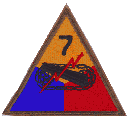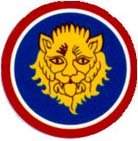


Click on the photo for a larger image.



The veterans of the 589th Field Artillery Battalion who were at the crossroads combined their written memoirs into a book that is a must for anyone who is researching the battle. While the book is by 589 FAB men, their accounts include important details of the actions and placement of all of the other units who were at the crossroads. The book is titled On the Job Training - The Battle of Parker's Crossroads. Click here to see the complete book on the Internet. To obtain a copy, send a $25 check, payable to:
The following quotations are from that book. But there is much more in the book about the general activity, and even if it does not mention 203 AAA specifically, they were there and experienced it. So anyone seriously interested in what 203 AAA experienced should buy this excellent book.
Contents of this Web Page
The final long day of battle was 23 December 1944. However, the pressure from the Germans was so intense that all of the 589 FAB memoirs of that day are focused on what was going on with them personally and their very immediate area, so that there are no references to 203 AAA. The same is true of the memoirs of the events after the Germans had overrun the crossroads. Men were captured or escaped in small groups or by themselves, so that the memoirs make no mention of 203 AAA.
|
Two tanks from the 7th Armored Division came into our area, in addition to the observer who adjusted fire on Samree. We were also joined by four vehicles from the 203rd Armored Anti-Aircraft Battalion, three of which were armed with four 50-caliber machine guns and one which was a self-propelled 37-millimeter gun. This group had been driven out of position south of the crossroads. We asked that they join us, and they agreed. |
|
(p. 42) We were joined by some AAA people with a towed traier mounted with four 50-caliber machine guns and a 37-millimeter cannon. I thought at the time I'd hate to be in front of that thing when it went off. (I onlu saw the one unit then, but the books reporting the action mention that there were four of these units there from the 203rd AAA, 7th Armored Division.) This weapon was positioned to fire directly down the road to Houffalize. Frank Aspinwall also reports that we were joined by a platoon of the 87th Recon Squadron. (p. 43) There we sat in this hole in the ground just waiting and watching, until about midnight when we could hear strange noises in the fog. It was very dark and our visibility was extremely limited, but we were able to discern what was making the strange noise as about a dozen Germans came into view on bicycles. They stopped in the road when they came on the mines. Being unaware of our presence, not ten yards away, they stood there in front of us in the middle of the road -- probably talking over what to do next. We could hear that the language was not English and they were wearing "square" helmets. Sewell and I were in big trouble. This was first for us to be this close to the enemy. Thinking that there were too many for us to take on with our carbines, I took the telephone and whispered our situation to Captain Brown. His orders were to "Keep your head down and when you hear my .45 the first time we will sweep the road with AAA quad 50's. When that stops, I'll fire my .45 again, and then we will hold fire while you two come out of your hole and return to the command post. Make it quick!" And that's the way it happened. The German patrol never knew what hit them. |
|
(p. 47) ... Major Parker had persuaded stragglers to stand and fight with us. They were: one light tank and crew from the 87th Recon Squadron; four 3-inch, high-velocity anti-tank guns and crews from the 643rd Tank Destroyer Battalion, and four anti-aircraft half-tracks from the 203rd AA Battalion, three mounting Quad-Fiftys, one mounting a 37-millimeter AA gun. (p. 48)Our second activity occurred about 2300 hours. Enemy infantry were reported approaching our positions from the east. The Quad-Fifty half-track covering that sector was alerted. They delivered devastating fire, which I watched from the road in front of the command post. It was beautiful and looked like four lines of giant fire flies chasing each other, however, I could not relate this beautiful sight to the carnage being created. A combat patrol was dispatched to "mop up" enemy survivors. The patrol found only one wounded German, many dead bodies, and scattered, mangled bicycles. |
|
Captain Brown (another courageous man and a great leader) cautioned us that a group of Germans on bicycles were reported on the road leading to our position. He told us that when the order to fire was given, everyone should fire down that road. Boy, when those quad 50's opened up, so did we. The roar was deafening. The order was given to stop firing. Then all night you could hear men moaning in pain and calling for help. Even though I knew they were the enemy, I couldn't help but feel sorry for them. |
|
Kenneth Sewll, also a light truck driver and lineman, was the man who set up the telephone line to this part of the perimeter and who set up the land mines on the road to Houffalize. He was the man who reported the German soldiers' arrival at the location of the land mines. His report to Captain Brown resulted in the direct fire on the Germans. It was an experience I'll never forget, seeing the AA people firing their quad 50-caliber machine guns and 37-millimeter cannon over my position from behind me. And hearing the riflemen firing down the road! All this firepower was effective in repelling this patrol. |
|
We therefore pulled in our perimeter. All vehicles were moved inside the perimeter, and two-man emplacements were dug at five-yard intervals around part of the perimeter. The perimeter was much smaller than it had been since we'd had a number of casualties during the afternoon. Even with this reduced perimeter, we were only able to cover the east and south of the perimeter and had to rely on the anti-aircraft guns and the vehicles of the reconnaissance group to cover the remainder of the perimeter. |
|
I had been outside during the night and concluded that Germans were preparing to attack before daybreak. We heard vehicles moving and were aware of movements of infantry. We decided rather than waiting for the Germans to attack, we would make a preemptive strike, simultating a counterattack by our forces. We commenced firing at 0530. Between the indirect fire of the armored field artillery, the direct fire of our three howitzers and the fire of the 50-caliber machine guns, it sounded like a full-scale battle. |
|
During the early evening, probably about 1730 hours, one of the anti-aircraft half-tracks, assisting in the defense of Baraque de Fraiture, received a direct hit from a German round. I suspect it was a large caliber mortar round, but of course I don't actually know what type of round it was. The results of this direct hit were swift and severe. From the command post we could hear the wounded men of the anti-aircraft crew screaming for help and also hear their 50-caliber ammunition starting to explode. The sight in the dark night was dazzling, but grisly dazzling -- of the half-track slowly becoming engulfed with flames fed by its gasoline and motor oil, and of the spectacular flight of exploding 50-caliber incendiary rounds as they arched high into the cold winter sky. I was stationed just outside the command post building, trying to make up my mind what I should do. Move to the half-track and try to assist the wounded men stationed there, or remain at my assigned post? The front door of the command post burst open while I was debating with myself, and Technical Sergeant Frank Tacker, the Battalion Inelligence Noncommissioned Officer, ran past me in the dark, shouting for someone to help him assist the wounded men in the half-track. My doubts now gone, I followed Sergeant Tacker into the night toward the burning half-track and its exploding ammunition. Frank Tacker reached the burning vehicle moments before I arrived, and with one powerful leap, cleared the armored side of the vehicle and landed feet first in the fighting compartment. In one fluid motion he lifted one wounded G.I. over the side of the half-track and dropped him into my outstretched arms. I barely had time to lower the body on his back in the snow when the second body came over the armored side of the half-track, quickly followed by Sergeant Tacker himself. At this point my heart was pounding and my breathing labored. I was terrified. Of course, I cannot speak for Frank. Outwardly he was calm as we checked the two men for wounds. It did not take a medical doctor to determine that one man was dead and the other badly wounded. I helped Sergeant Tacker place the badly wounded man on his shoulders, and he started carrying this man on the long, slippery, and dangerous trek back to the command post and to a waiting medic. As I tried to drag the dead G.I. body away from the fury of the burning vehicle and the exploding ammuniition, the badly burned flesh of the man's wrists and forearms came off on my woolen gloves. I quit dragging the body, moved away from the burning vehicle, leaned over in the darkness, and retched in the snow. The terrible sight and horrible smell caused by the burned flesJh was too much for my stomach. How my friend Frank Tacker managed to carry the heavy weight of the wounded man back to the command post through the ice and snow, and in the darkness, is beyond me. ... Fiction writers would give this incident a happy Hollywood ending. History does not. The severely wounded man died on Frank's shoulders before they reached the command post. ... |
Click here for an active overview of all pages at the 7th Armored Division web site